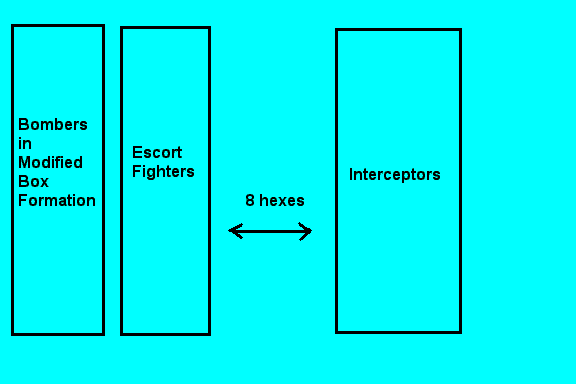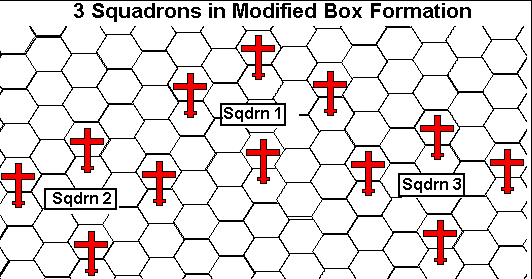
Historical Background: The B-17 Flying Fortress was the principal heavy bomber of the US during WW II. The plane was used for daylight bombing missions against industrial targets in Europe and, to a lesser extent, the Pacific Theatre. The B-17 was armed with machine guns in the nose, tail, sides, belly, and top. When in formation this gave them the ability to effectively defend themselves against German fighters. Still, more than 4,000 B-17s were shot down by interceptors. Anti-aircraft fire claimed even more of the bombers. Often the B-17s would be accompanied by escort fighters such as the P-47 and P-51. One famous group of escort fighters was the Tuskegee Airmen. Although the US army was segregated, and African Americans were routinely given non-combat assignments, the Tuskegee Airmen were a remarkable exception. They painted the tails of their planes red and were often called the "Redtail Angels." They achieved the amazing feat of never losing a bomber to enemy fighters. Their impressive accomplishments helped to change racist attitudes in the army and President Truman officially ended segregation in the military in 1948. The Germans built many excellent fighter planes during the war, including some jet aircraft. One of these was the Messerchmidt-262 "stormbird." Although it was deployed in too few numbers and too late in the war to make a difference it was a sign of things to come.
Design of Rules: This set of rules is based on the WW II Fast Aerial Combat rules developed by Mic McGoldrick and Bill Molyneaux.
Battle 1: The German interceptors flew right past the American escorts so that they could jump right on the B-17s. The tactic was effective and the leader bomber of both formations took a critical hit, slowing the entire formation. The American escorts turned and attacked the German planes from behind, thinning their ranks. The Americans concentrated on the jets. The German attackers soon learned that it was a bad idea to fly through a formation of B-17s. The first to try it found themselves in a hornet's nest, fired on from all sides. The others learned from this and tried to attack the formation from along the edges. The German attacks were very effectively, and only three of the B-17s made it to their targets.
The models: Plastic model planes are readily available in 1/144 scale. The 1/144 models are cheap, and just the right size. They are also very easy for the students to build. You can find die-cast planes from manufacturers like Sky Wings, In Air, Corgi and Model Power. Look for planes sold in sets at toy stores for the best deals. The scale of the die-cast planes is inconsistent, so be careful when buying them if this is a concern. Here are some simple paper airplane models you and print and use. Additional free paper airplanes are available from a lot of web sites, just look around. Paperworlds.com and FreePaperToys.com is a good place to start a search. You can also purchase origami airplane models for at Fiddler's Green and Papertigerarmaments.com.
The Board: The battle is played on a 7.5' x 5' hex map. The hexes should be about 3" in size and can be drawn by creating and tracing a template made from cardboard or card stock. The grain of hexes should run from end to end so that planes can fly straight the full 7.5' length of the table.

Deployment: The planes should be deployed as shown on the map. The bombers should start in Modified Box Formation. The fighters should be grouped together in squadrons of four. Enemy planes must start at least 8 hexes apart.
Objective: The German players must attempt to shoot down as many bombers as they can before the bombers move off the end of the board or time runs out. The number of fighters shot down is of no consequence, it's all about the bombers.
Order of Battle: This battle is meant to represent a B-17 mission flying over Germany with fighter escorts. The escort aircraft should be P-47s or P-51s. It adds some interest to the battle if the escorts are Tuskegee Air Men (paint the plane's tails red). The German interceptors are Me-109s, FW-190s, and a squardron of Me-262s. This battle could also be played with British Lancasters and British escort fighters, or moved to the Pacific with Japanese Zeroes as the interceptors.
|
United States (Escort Fighters can be P-47s, P-51s, or other suitable planes) |
Germany (Interceptor Fighters can be ME-109s, FW-190s or other suitable planes. Jet Interceptors can be Me-262s) |
 The Rules
The Rules
Sequence of Play:
1. Bombers Move
2. Bombers Shoot
3. Interceptors Move
4. Interceptors Shoot
5. Escorts Move
6. Escorts Shoot
Airplanes in Hexes: Airplanes should be positioned in their hexes so they face one hexside, not a corner. Only one plane is allowed in each hex, but planes can move through other planes during movement as long as they don't end up in the same hex. Bombers occupy two hexes. During movement a plane must always move at least one hex, it can't stay in the same hex.
Bombers Move: Bombers can move three hexes and may only move forward or side slip. They cannot make turns. Bombers should try to stay in formation. Bombers lose one hex of movement for each engine that has been lost. Bombers that lose three engines and are reduced to speed zero are considered to be shot down and are removed from the board.
Bombers Shoot: B-17s had guns in the nose, tail, belly, sides, and top. Bombers can shoot once at EVERY enemy plane that is within two hexes of either of the two hexes occupied by the bomber unless the line of sight to the plane is blocked by another bomber or friendly plane. Bombers always roll 2 dice when shooting at enemy planes and score hits on a roll of 4 - 6.
 Recording
Damage: It takes 5 hits
to shoot down a fighter, and 20 hits to shoot down a bomber. The
hits should be recorded by adding or removing markers on the plane's
base or wings, or a written record can be kept. When a plane is
shot down it is removed from the board.
Recording
Damage: It takes 5 hits
to shoot down a fighter, and 20 hits to shoot down a bomber. The
hits should be recorded by adding or removing markers on the plane's
base or wings, or a written record can be kept. When a plane is
shot down it is removed from the board.
Escorts & Interceptors Move: Ordinary fighters can move 5 hexes and jets can move 9 hexes. Fighters and jets can move ahead or side slip, and can include one turn of 60-degrees (one hex-side) in their move. Fighters and jets can also make an Immelman turn (also known as a slit-S). To perform the Immelman turn an ordinary fighter must move 3 hexes straight ahead, and in the third hex it turns 180-degrees. The plane cannot pass through any planes during the 3 hex move if it wishes to execute an Immelman turn. For jets the Immelman turn takes 6 hexes of movement. Planes can use their additional movement to move normally before and after the Immelman turn.
Escorts & Interceptors Shoot: Ordinary fighters and jets can only shoot at targets that are in the line of hexes directly in front of their nose. Their maximum range is 4 hexes. They may only fire at the closest enemy plane. If a friendly plane blocks the line of sight to the nearest enemy plane then they can not shoot. They roll 4 dice at targets one hex away, 3 dice if the target is 2 hexes away, and so on. Hits are scored on rolls of 4 - 6. If a fighter scores a hit on a bomber by rolling a 6 there is a chance for critical hit to an important piece of equipment, such as an engine. Roll again for each 6 rolled against the bomber. A critical his is scored if the second roll is a 4 - 6. Critical hits are indicated by putting cotton on the bomber.
|
|
|
||||
| Range | 1 | 2 | 3 | 4 | |
| Fighters and Jets | 4 | 3 | 2 | 1 | |
| Bombers |
|
2 |
|
|
|
|
|
|||||
Resources: Here are some useful resources for WW II bomber missions